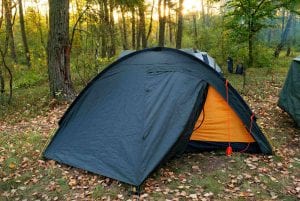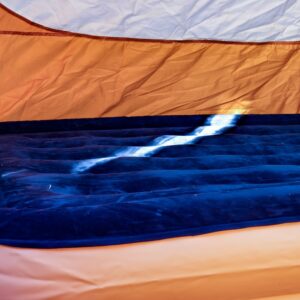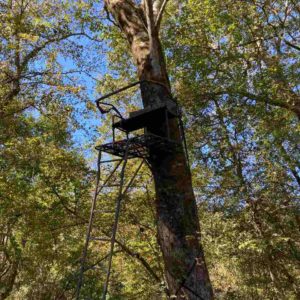Camping in the rain gets a bad press. Sure, it doesn’t look very appealing in the outdoor gear catalogs, but just think back to your most memorable family camping trips.
Were they the ones where everything went to plan, or the ones where you all banded together and triumphed over the elements, snatching victory from the jaws of defeat?
Wet-weather camping doesn’t have to be an ordeal, so long as you know what you’re doing.
We’ve put together a list of 40 tips and hacks for high times under low skies.
- Fail to plan, plan to fail. If you’re expecting rain, you’ll want to double-check your gear and clothing and think carefully about your tent set-up.
- It’s all about morale. Happy campers don’t mind getting wet, but they still need warm beds, plenty of activities, and a few home comforts to lift the mood.
- Manage your wet gear to stay warm and comfortable. Dry it if you can, but above all keep it away from your spare stuff.
- Embrace the adventure, but have an escape plan just in case.
Planning
Keep an Eye on the Weather Forecast
When it comes to the great outdoors, forewarned is forearmed. If the forecast for your camping trip is a week-long string of black rain clouds, you’ll know to pack the oilskins and Sou’westers.
Bring Lots of Waterproof Bags
You can’t have too many waterproof sacks.
Pack proper dry-bags to store gear like electronics and sleeping bags, plus a roll of heavy-duty trash bags for quarantining wet kit and protecting dry clothes.
You can also use them as mats to keep mud off the floor of your tent.
Make Sure Your Tent Is Waterproof
Don’t leave it until the first night of your camping trip to discover that your rain-fly leaks like a sieve. Re-proof or seam seal your tent if necessary, and maybe replace it if it’s seen better days.
Check out our guide to tent fabrics for more insight into this.
Bring Extra Tarps and Cord
Spare tarps can be used to reinforce your tent floor, to protect your camping gear, to dry firewood, or even to improvise an awning for cooking and sitting out.
Don’t forget some extra rope and paracord too!
Pack Extra Clothes
Drying wet clothes can be tricky when the weather won’t let up. If you’re expecting rain, make sure you’ve got plenty of extra clothes and make sure you pack them in waterproof bags so the damp doesn’t sneak in.
Don’t Rely On a Campfire
Campfire cooking is the dream. The aroma of woodsmoke; steaks broiling on the grill… but what if the reality is 45 minutes hunched over a heap of sopping wet firewood, trying in vain to coax it into life?
As the cold and rain seep into your bones, you’ll be glad you packed that back-up propane stove.
Pack Food That Doesn’t Need to Be Cooked
Really heavy rain rarely lasts long, but it does seem to like to strike at mealtimes.
It’s always worth bringing some meals that can be eaten cold in your tent, just in case going outside with the cooking gear is a truly appalling thought.
Have an Evac Plan
99% of the time, a rainy camping trip will go off without a hitch. But, just occasionally, fate has other ideas.
Campsites can flood, tents can buckle under the weight of rainwater, or electrical storms can make it dangerous to be out in the open.
It’s better to have a bug-out plan than be caught unawares.
Think about where you’ll move to if need be (to higher ground, lower ground, or an indoor shelter?) and how you’ll get there. If you’re car camping, is your vehicle parked on firm ground where it won’t get bogged down?
Keep your gear organized in such a way that you can pack it up in a hurry (along with kids, dogs, etc.), and make sure you know how to get your tent down in double-quick time.
Setting up Camp
Camp On Higher Ground
Lower-lying ground will usually hold more rainwater, so you’re better off camping a bit higher up — though, remember not to leave yourself too exposed if thunderstorms are forecast.
Don’t Camp at the Bottom of a Slope
The laws of gravity being as they are, camping at the bottom of a slope is a good way to arrange a stream of rainwater running through your tent.
Don’t Camp Next to Lakes or Streams
Some areas are particularly prone to flooding, including riverbanks and lakeshores.
Remember that water levels can rise very quickly, and that floods can result from heavy rain a long way upstream — even if it’s much drier where your tent is.
Camp Near Trees
Trees can provide useful natural shelter from wind and rain. Just make sure you avoid pitching your tent close to dead trees, and inspect any nearby ones to make sure they look healthy. You want to look out for deadfall that might get dislodged by heavy weather!
Reinforce Your Groundsheet
Rainwater can get into your tent through the floor as well as the roof. Most tents have pretty heavy-duty groundsheets, but if you’re worried that water will pool beneath then you can add an extra tarp or liner either under the tent bottom or on the inside.
Hang a Larger Tarp Above Your Tent
Some campers like to suspend an extra tarp over their entire tent, essentially giving themselves a double flysheet. Most tents won’t need this, but it can be a useful trick if your flysheet is leaky and you need to keep your tent dry.
Because the second tarp needs to be hung quite high above the tent, this doesn’t work well in windy conditions. You also need to make sure that the rainwater running off the tarp doesn’t end up pouring onto (or into) your tent.
Improvise a Doormat with an Old Rug or Towel
Trailing muddy waterproof boots into a tent is a quick way to turn it into a quagmire, so you need a place where people can either wipe their wet feet clean or — even better — switch into sandals or slippers as they come through the tent door.
Consider a Hammock Camp
For hikers, a lightweight hammock and tarp shelter set-up can be drier than a hike tent — particularly if you’re camping on wet ground where the rain might seep in from below.
Lifting the Mood
Use Lights to Cheer the Place up
Wet weather camping is all about staying cheerful. When it’s dark and damp outside the tent, fairy lights and lanterns can really brighten the mood — as well as help you see your Uno cards.
Rig up a Covered Space Outdoors
Normally you’d spend more time outside your tent than in it, but sitting in a camp chair watching the world go by isn’t nearly so appealing when you’ve got torrential rain running down your neck and pooling in your underwear.
Try rigging up a covered awning or outdoor area where you can sit out, cook, play, and generally enjoy the fresh air without getting soaked.
Keep Dry Wood and Kindling for Campfires
A crackling fire is one of the best morale-boosters in bad weather, but we’ve all had those depressing damp squibs where the wood smolders and hisses with all the warmth and cheer of a Werner Herzog movie.
Avoid this by keeping a stock of dry wood, plus kindling and waterproof matches, to get the fire started. Good quality seasoned hardwood will almost always be better than anything you can forage, but remember to “buy it where you burn it”.
Have Plenty of Rainy Day Camping Activities
It’s in the nature of a rainy camping trip that you’re going to be spending more time inside than usual, so plan accordingly.
Bring books, games, and spare power-packs for your electronics. Plus, you can do your research beforehand about indoor attractions like museums or galleries.
Be Careful on Wet Ground
No camper should end up in a cast. Wet grass, greasy rocks, and muddy ground can all lead to slips and falls, especially if you’re wearing bulky rain gear with your hood up.
Enjoy Camping in the Rain for What It Is
Funnily enough, the washout camping adventures are sometimes the ones you remember most fondly.
Camping in the rain is a different experience to a camping trip in warm, dry weather — and you can either be miserable about it or enjoy the camaraderie and excitement of it all.
The key is being able to get warm and dry when you want to be.
Keeping Warm and Comfortable
Have Hot Drinks
When you’re camping in the rain, you tend to come back from activities a bit cold and wet. Rather than sitting around the tent feeling uncomfortable, get changed into some dry clothing and warm up with hot drinks and snacks as soon as you get inside.
Wear Layers
Layering is the key to rainy weather comfort. Several thinner layers will help trap warm air and make sure you stay dry.
Wear the Right Fabrics
Cotton clothes and denim aren’t great for inclement weather because they take a long time to dry and can get very uncomfortable when they’re damp.
Instead, you could try quick-drying synthetics or good old-fashioned wool. Merino wool, in particular, is great for itch-free base layers that stay dry, wick moisture away from your skin, and don’t need washing very often.
Keep Your Sleeping Bag Dry
As any seasoned hiker knows, it doesn’t matter how wet you get during the day, so long as you can sleep warm in a dry sleeping bag. The same goes for camping in the rain. Keep your sleeping bag well away from anything wet, and stick it in a waterproof bag when you’re not using it.
If you’ve got a choice between a down or synthetic bag and weight isn’t an issue, then you’re probably better going for the synthetic. Down is great for cold weather, but despite developments in “hydrophobic” coatings, down sleeping bags lose insulation very quickly when they get damp and are also difficult to get dry.
Change Into Dry Clothes Before Bed
When you’re camping in the rain, it’s all about the little luxuries — like a set of really dry clothes just for sleeping in. Change into them last thing before bed and pack them away with your sleeping bag in the morning.
Avoid Condensation
Condensation can be the worst in rainy weather. Even in a dry tent, the clothes you put on first thing in the morning might feel a bit cold and damp.
Get around this by stashing them in the bottom of your sleeping bag. Then, they’ll be lovely and warm when you start your day.
Another “hack” that’s often mentioned for camping in the rain is to sleep in a waterproof bivvy bag (also known as a bivouac sack). While this seems like a great idea in theory, anyone who’s ever used one will know that you pretty much always end up with condensation on the inside.
This level of moisture is fine if you’re sleeping outside in the open air (which is what a bivvy bag is made for), but it makes no sense if you’re in a tent.
Add Extra Insulation Under Your Sleeping Bag
To keep the cold and rain out, consider putting extra insulation under your sleeping pads, or raising yourself off the ground with a cot.
Put Hand Warmers in Your Boots
Cold, damp boots are one of the least pleasant things about camping in the rain. Warm them up with store-bought hand warmers or even leak-proof bottles of warm water.
Bring Good Rain Kit
You’re only as good as your inclement weather gear — which should include a minimum of a waterproof jacket (or poncho), rain pants, and waterproof shoes. All these things will lose their waterproofing over time, so make sure you’ve re-proofed your rain suit before you set off.
If you’re doing anything strenuous like hiking or biking, it’s important to buy rain gear that’s breathable. Otherwise you’ll just get wet from the inside rather than the outside.
And, if you really don’t want to get your feet wet in the rain, you might also consider gaiters and waterproof socks.
Make Sure Wet Gear Doesn’t Contaminate Dry Gear
Quarantining wet kit in your tent is an essential skill for camping in the rain. It only takes one soaking wet waterproof dropped in the wrong place to leave you with no dry underwear for the rest of the week.
Designate “wet” and “dry” areas of the tent, and make sure your dry clothes are always kept in waterproof bags.
Use Your Tent Porch
Peel off your wettest gear, like jackets and waterproof pants, and keep them out in the tent porch. If you haven’t got a porch or if the area is too small, you can use a tarp and some paracord to rig one up.
Don’t Forget the Umbrella
You might not be walking to work at the bank or playing golf, but a nice big umbrella has a myriad of uses around a rainy campsite. Just don’t put it up in the tent.
Wear Pull-On Footwear
One thing that quickly becomes tedious about rainy weather camping is the amount of time you spend getting your boots on and off at the tent entrance. Ditch the lace-ups and embrace the slip-ons, even if it’s just as simple as a pair of rubber boots.
Getting Things Dry
Tackle Wet Gear ASAP
Don’t leave your wet clothes lying around the tent. Hang wet clothes up, dry them if you can, or even just bag them up in waterproof trash bags to deal with when the sun comes out.
Stuff Newspaper in Your Boots
It’s the oldest trick in the book, but it works. Scrunch the newspaper up into loose balls and replace them as they soak up the moisture.
Find or Build a Drying Room
Campgrounds catering mainly to hikers will often have heated drying rooms available. You can leave things to dry overnight, and the unique smell is something that never really leaves you.
If there isn’t a drying room and the rain isn’t letting up, you can rig up a large tarp with washing lines under it so that at least you have a dry space where the wind and fresh air can get to your wet clothes.
Hang Some Items in the Tent
This can be a tricky one. Your inner sanctum needs to be kept dry, but if it’s big enough and warm enough then you might be able to get away with drying a few important items in the tent — especially if you’ve got a tent stove.
Remember to Air Your Tent During Dry Periods
A sealed tent full of damp camping gear can get very humid. When the rain stops, open up the doors and get some air through it.
Dry Everything When You Get Home
If you have to pack things up wet, make sure you dry everything when you get home from your camping trip. Most important is to get your tent dry before you store it away.
FAQs
What to Do if It Rains While Camping?
Bring the right gear, dress in layers, and make sure you don’t mix wet and dry kit. Look after your morale, keep your bed dry, and tweak your tent set-up if you need to.
Is It a Bad Idea to Camp in the Rain?
Most of the time it’s fine to camp in the rain, so long as you’ve planned for it and brought the right rain clothes and camping gear. However, it’s always worth having an escape plan just in case.
How to Camp in the Rain Without Being Miserable?
Camping in the rain is all about keeping warm, comfortable, and entertained. Plan plenty of rainy day camping activities, warm up with hot drinks and snacks when you get back to your tent, and use campfires and fairy lights to lift your mood.
Above all, make sure you stay warm and dry at night.
You never know — it might end up being your best camping experience ever.
What are the Best Hacks for Camping in the Rain?
Bring extra tarps and waterproof bags, dress in layers, and quarantine your wet clothing so it doesn’t contaminate your dry stuff.
But the best tip for camping in the rain is just to stay positive and embrace the adventure!





